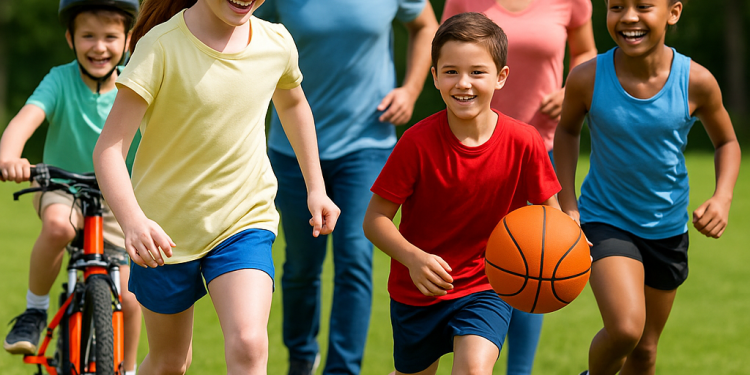Sports are more than just games—they’re a foundation for building confidence, teamwork, and lifelong health in children. In today’s digital age, when screens often replace outdoor play, getting kids involved in sports is more important than ever. Whether your child dreams of scoring a goal, making a slam dunk, or just wants to have fun and make friends, youth sports in the USA offer countless benefits for both kids and families.
This comprehensive guide will show American families how to encourage children to participate in sports, share the best tips for family fitness, and highlight popular sports activities for children in 2024. Let’s help your family stay active, connected, and healthy together!
1. The Importance of Kids Sports in the USA
Building Healthy Habits Early
- Physical fitness: Regular exercise through sports activities for children keeps their bodies strong and supports healthy growth.
- Emotional well-being: Kids who play sports are less likely to experience anxiety or depression, and often develop greater resilience.
- Academic and social skills: Team sports teach responsibility, discipline, and time management—skills that benefit children both on and off the field.
A Path to Lifelong Health
Youth sports set the stage for a healthy lifestyle, reducing risks of obesity and chronic diseases later in life. Healthy families in America often have active routines, and involvement in sports is a cornerstone.
2. Choosing the Right Sport for Your Child
Understand Their Interests and Personality
- Ask what sports your child is curious about—don’t just pick what you loved as a kid.
- Introverted kids might prefer individual sports (swimming, track, gymnastics), while social butterflies may thrive in team sports (soccer, basketball, baseball).
Age-Appropriate Options
- Ages 3-5: Focus on fun, simple activities like swimming, tumbling, or soccer basics.
- Ages 6-9: Try organized sports like T-ball, basketball, youth soccer, or martial arts.
- Ages 10-12+: Encourage multi-sport participation, letting kids sample baseball, volleyball, football, tennis, etc.
Try Different Sports
It’s OK if your child wants to switch—exploration helps kids find what excites them and prevents burnout.
3. Making Sports Accessible and Fun
Start at Home
- Play catch, ride bikes, or set up obstacle courses in the backyard.
- Make physical activity a family routine—family fitness walks, weekend hikes, or dance parties in the living room.
Community and School Programs
- Check local recreation centers, YMCAs, and community leagues for affordable options.
- Many schools in the USA offer after-school youth sports programs for all skill levels.
Focus on Fun, Not Perfection
- Celebrate effort and improvement, not just winning.
- Let kids enjoy unstructured play as much as organized sports.
4. Overcoming Common Barriers
Time Constraints
- Look for programs with flexible schedules.
- Rotate practice drop-offs with other parents or carpool to save time.
Financial Challenges
- Many communities offer scholarships or reduced-fee programs for kids sports USA.
- Buy used gear, swap with other families, or check for sports equipment donation programs.
Motivation Issues
- Set family fitness goals—like trying a new activity every month.
- Let kids invite friends to practices to make it more social.
Anxiety or Fear of Failure
- Normalize making mistakes and learning new skills.
- Remind children that not everyone is a star on day one.
5. Popular Sports Activities for Children in the USA
Team Sports
- Soccer: The most popular youth sport in America for both boys and girls.
- Basketball: Fast-paced and great for coordination.
- Baseball/Softball: Teaches patience, strategy, and teamwork.
- Football (Flag or Tackle): Builds strength and camaraderie.
- Volleyball: Increasingly popular, especially among girls.
Individual Sports
- Swimming: Essential life skill and excellent full-body workout.
- Gymnastics: Builds flexibility, strength, and confidence.
- Martial Arts: Great for discipline, respect, and self-defense.
- Track & Field: Encourages kids to set personal goals.
Emerging and Alternative Sports
- Esports: Organized, competitive gaming is on the rise—balance is key!
- Skateboarding, Surfing, Climbing: New Olympic sports that appeal to adventurous kids.
- Pickleball: Rapidly growing and fun for all ages.
6. Family Fitness: Getting Involved Together
Lead by Example
- Kids imitate what they see. Show enthusiasm for physical activity—walk, bike, or play sports as a family.
Create Active Traditions
- Saturday morning soccer games in the park, family bike rides, or joining a fun run together.
Support and Celebrate
- Attend games and practices, cheer from the sidelines, and celebrate both effort and achievement.
Encourage Screen Breaks
- Designate certain hours or days as “no screens, let’s move!” time.
7. Supporting Your Child’s Sports Journey
Emphasize Effort, Not Just Winning
- Teach that trying hard and improving is more important than being the best.
Be a Positive Sports Parent
- Avoid sideline coaching or pressure.
- Focus on encouragement and letting coaches do their job.
Communicate with Coaches
- Stay in touch with your child’s coaches to understand expectations and monitor progress.
Watch for Signs of Burnout
- Kids should look forward to practices—not dread them.
- Take breaks if needed and respect your child’s wishes to try something new.
8. The Social and Emotional Benefits of Youth Sports
Building Confidence
- Mastering a skill or playing on a team gives kids a sense of accomplishment.
Making Friends
- Youth sports are one of the best ways for children to develop friendships outside school.
Learning Teamwork and Respect
- Working with teammates and coaches builds cooperation and empathy.
Coping with Winning and Losing
- Sports teach resilience, humility, and how to handle both success and setbacks gracefully.
9. Keeping Kids Safe and Healthy in Sports
Warm Up and Cool Down
- Teach the importance of stretching and hydration.
Preventing Injuries
- Use proper equipment, follow safety guidelines, and encourage open communication about pain or discomfort.
Mental Health
- Watch for stress or anxiety—remind children it’s okay to talk about how they feel.
Balance
- Avoid over-scheduling; rest is just as important as activity.
10. Celebrating Diversity in Youth Sports
- Encourage participation regardless of gender, background, or ability.
- Support programs that offer adaptive sports for children with disabilities.
- Highlight diverse role models in sports to inspire all kids.
11. Long-Term Impact: Building Healthy Families in America
Youth sports have ripple effects:
- Children who are active become healthier adults.
- Sports participation is linked to better academic performance, self-esteem, and leadership skills.
- Active families grow closer, communicate better, and share more positive memories.
Conclusion: Let’s Get Moving, America!
Getting kids involved in sports is one of the best gifts you can give your family. It’s about more than trophies or scoreboards—it’s about health, happiness, and habits that last a lifetime.
Start small, explore options, and above all—make it fun. Whether your child becomes a future star or simply finds joy in movement, youth sports in the USA can set the stage for a stronger, healthier, and more connected family.
Ready to begin? Explore local programs, ask your kids what excites them, and join the movement for healthy families in America—one game at a time!
Alt text for images:
A joyful American family—kids and parents—playing soccer, riding bikes, and laughing together in a park, showcasing youth sports and family fitness.


















































